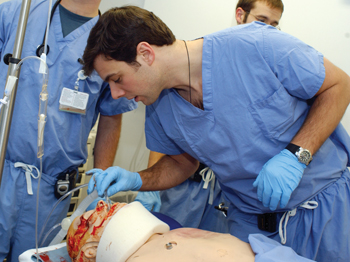
James Woods, M.D., checks the airway in a simulation training session, one of the many ways VUMC works to enhance patient safety.
Photo by Dana Johnson
Safety gains hinge on culture change: panel
As many as 98,000 hospital patients die annually from medical errors, yet the nation's health care system continues to give short shrift to safety.
So said nationally known patient safety experts during a daylong symposium on patient safety and medical simulation Feb. 3 at the Vanderbilt Student Life Center.
“Health care is a hazardous industry just like aviation, just like nuclear power,” said Jeffrey Cooper, Ph.D., founder and executive director of the Center for Medical Simulation in Boston.
Yet unlike those industries, he said, health care has not taken the steps necessary to put patient safety first.
“The barriers to real change are high,” said Cooper, an associate professor of Anesthesia at Harvard Medical School. “You're talking about dramatic culture change.”
For several years, Vanderbilt University Medical Center has committed to just such a culture change through programs ranging from StarChart to participation in the Leapfrog Group's Hospital Quality and Safety Survey, and, more recently, the wide-ranging improvement effort known as elevate.
Those efforts are bearing fruit. According to F. Andrew Gaffney, M.D., VUMC's chief quality and patient safety officer, the number of deaths among patients with a low (below 10 percent) expected mortality rate dropped by 200 between 2003 and 2005.
“This is really the crux of what we've done,” said Gaffney, associate dean for Clinical Affairs and professor of Medical Education and Administration.
“Two hundred people went home rather than becoming a statistic.”
The symposium was sponsored by the Center for Perioperative Research in Quality, part of a major effort at Vanderbilt to enhance training of health care professionals through innovations such as medical simulation.
Center director Matthew Weinger, M.D., said that too often employees are simply blamed for failing to implement safe practices.
“That's completely the wrong approach,” said Weinger, professor of Anesthesiology, Biomedical Informatics and Medical Education.
“The right approach is to step back and say, 'What can we do to make it easy in the practice of care to get the outcome we want to get?'”
In the area of medical education, Bonnie Miller, M.D., associate dean for Undergraduate Medical Education, described curriculum revisions that have balanced knowledge with skills, and basic sciences with social sciences.
Medical educators must become adept in “coaching future physicians,” she said, just as athletes are trained to improve their performance.
Other Vanderbilt speakers described efforts to minimize collateral tissue damage during minimally invasive surgery, improve treatment of delirium in mechanically ventilated patients and reduce medication errors in the pediatric critical care unit.
Cooper and David Gaba, M.D., associate dean for Immersive and Simulation-based Learning at Stanford University School of Medicine, recommended several steps to establish a culture of safety:
• Start with yourself. “Go home and do something to improve your own safety,” Cooper said.
“If you want to change the behavior of other people, you have to learn how to change your own. You'll see how really difficult it is.”
• Practice emergencies routinely. “We still don't do regular fire drills in our hospitals,” he said. “I think hospitals ought to be shut down for a day … at least for elective procedures … to do safety procedures.”
• Train everyone, including hospital administration, in safety. Reward employees for admitting mistakes and pointing out safety problems.
• Encourage patients to talk about negative experiences they've had. Advertise the hospital's safety record in the lobby.
“Imagine walking into your hospital lobby, and there's a billboard (that) says how many days or hours since a patient had been injured,” Cooper said. “If you put people in a culture like that, they'll really start to live and breathe it.”
• Make patient safety a public health issue. “Ultimately the biggest driver is the public,” said Gaba, a professor of Anesthesia.
“If the public really knew how dangerous much of health care was, they probably wouldn't stand for it.”













